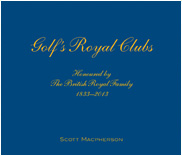GOLF CHAMPIONSHIPS ON SMGD COURSES:
At Close House – Colt Course. Sept 2017. A prestigious European Tour Championship hosted by Lee Westwood.
Broadcast worldwide from Royal Wellington Golf Club, NZ. October 2017. WOW!
The legacy continues.
Co-hosted at the award-winning Millbrook Resort near Queenstown, NZ. 2014 – 2023.
Favourite Design Books
What are the best books on golf course design written by golf architects?
By Scott Macpherson
Golf Architect, Author, B.Hort Tech (Hons)
Date: August 2019.
Written for: Through The Green Publication.
I happen to be of the opinion that golf is the game with the finest literature. It took scribes a number of centuries to collect their thoughts on the game before the first books were published in the mid-eighteenth century, but once they did, we have been inundated with an avalanche of exceedingly enlightening, thought provoking, studious, colourful and witty works. No corner of the game has been overlooked either – if you fancy prose, it’s there, beyond it are delightful flights of fancy in the form of fiction, and that tower of books behind is the ever increasing amount of instructional books. My interest has always been golf course design and architecture. It may be regarded as an artisans section, but it too has grown in size thanks to the contributions of creative, learned and talented authors. As a practising golf course architect myself, my collection of books on design has grown through the years, yet for design aficionados, there is an interesting sub-category which are books on golf course design by golf course architects themselves.
How many designers have taken the plunge to lay out their ideas in a written format, and have enough to say to fill a book, is unknown. Of the books that have been published, I cannot say how many have been commercial or vanity pressings either, but the range consists of large and small books, some illustrated, some technical, but all written with conviction and welcomed within the landscape of golf literature.
When I first think of books dedicated to advancing the subject of golf course design, and cast my mind to my working library – a collection of books used for reference and inspiration – I notice that a number of very good – even great – books have been written by those who were not full-time designers, or are books that might only have a single section on golf design. For the purposes of this article, these books will not make my final Top 10 list of golf design books written by golf designers, but I would like to mention some:
- Willie Park Jr. (born in Musselburgh, 1864) won the 1887 Open Championship and was an entrepreneurial pioneer and prolific designer. Often recognised as being the first golf architect because he formed a company, created plans, and documented his philosophies, his designs can be found across the UK and USA and include the old course at Sunningdale, Huntercombe and Maidstone on Long Island. But he also broke ground in literature by becoming the first golf professional to write a book. The Game of Golf, (Longmans, 1896) covered a series of topics, and featured an insightful chapter on golf course design entitled, ‘Laying Out and Keeping Golf-Links’. This is a terrific chapter, and so the book is of value to those interested in golf course design.
- The Links by Robert Hunter (London, Charles Scribner’s Sons, 1926) is one of the foremost books on golf course architecture. Most architects own a copy and have poured over it countless times while establishing and testing their own design philosophies. In the foreword to the Flagstick Books edition in 1998, prominent US designer Bill Coore writes about the distressed condition of his original copy with its ‘…frayed edges and broken binding releasing pages and threatening a complete unravelling at the slightest hint of further use.’ However, while a masterpiece, Hunter himself was not a full-time golf architect. He certainly was involved in the business and after teaming up with Dr. Alister MacKenzie is credited with work on such luminary courses as Cypress Point and Pebble Beach, but is seen as a ‘conceptualist, assisting Mackenzie with his deep understanding of the game and its links.’(1)
- Fans of American Albert Warren Tillinghast (b.1874 – d.1942), aka ‘Tillie’, know him as a colourful character with a great talent for golf course design. After being involved in a gang in his youth, he moved into more aristocratic circles after marriage and began collecting art, china and furniture, dabbled in polo, cricket and bridge, and self-published a book of maudlin prose. It was his several summer visits to St Andrews that fired his enthusiasm for golf, and after taking lessons from Old Tom Morris, Tillinghast competed in the US Amateur a number of times between 1905-1915. At the age of 32 he laid out his first course on the family farm in Pennsylvania of pump magnate Charles Worthington, and the rest is history. Discovering he liked the work, it was well paid and honest, he set up a design & build company and was soon a successful millionaire. Requests for his services continued until the Great Depression and include stand-out work such as Winged Foot and Baltusrol, but things eventually dried up and he was left almost destitute. After a failed last gasp attempt to right his fortunes by opening an antique store in Beverly Hills (with much of his own furniture for sale), he moved in with his daughter in Ohio and died soon after. The golf world forgot about him until 1974 when four of the USGA Championships were played on Tillinghast designs. He was a prolific writer and coined the word ‘birdie’ for a hole played in one less than par but never wrote a book on golf course design. What we have are a number of his essays that were complied by R.C.Wolffe and Robert S. Trubus over a six year period into a great trilogy that gives us the best insights into Tillie’s design philosophies. This series, including The Course Beautiful (1995), Reminiscences Of The Links (1998) and Gleanings From The Wayside (2001),is a must have for any serious golf design library as a collection of essays by one of only six golf architects in the World Golf Hall of Fame.
- Hazards by Aleck Bauer. (Chicago, IL. Toby Rubovits, 1913) Sometimes quoted as being the first book on golf course design, this book as actually a compendium of articles by the likes of MacKenzie and Colt, but also features a number of plans of the most famous holes. An excellent early book.
- Concerning Golf By J.L. Low (London, England, Hodder and Stoughton, 1903)Low (b.1869-d.1929) was a towering figure in golf as a player, writer and administrator. He had strong thoughts on the benefits of intelligent golf course design and was a leading advocate during the Golden Age. His book features an excellent chapter entitled ‘Concerning The Links’, and is a compelling manifesto for strategic design philosophies. I adore this book. For more on Low, search for ‘The Articles of Faith according to John Low’ (2)
Other meritorious books that are terrific but miss out on my list by being biographical books on architects rather than design books include:
- Colt & Co – Golf Course Architects. By Fred Hawtree. (Cumbac Archive, UK. 1991.)As an admirer of Harry Colt’s work, this book is one I have often referred to. Hawtree, with the research assistance of Gil Hanse, produced the best reference book that documents Colt’s life and work with his design partners. When I was preparing to design the Colt Course at Close House in Newcastle, UK, (named in honour of the great man), I visited 43 Colt courses around UK and Europe and this book was always with me.
- The Life & Work of Dr Alister MacKenzie by T.Doak, J.S.Scott, R.M.Haddock, (Sleeping Bear Press, 2001). When it comes to MacKenzie, it’s always been difficult to separate the man from the mystery. This coffee table book is a complete account of his design philosophies and features numerous photos and diagrams of his work and is a staple for any design library.
- Simpson & Co – Golf Architects. By Fred Hawtree. (Rhod McEwan Publishing, Ballater, 2016.) We know much about Simpson from his own writings, but here is a fresh look into the life of golf’s most colourful characters from a new perspective and 50 years after he died. Beautifully produced with colour plates and photos, the book gives us a fresh look at a designer who worked through two world wars and touched many of the great British courses. My favourite part of the book is the peep into his private ‘Golf Architect’s Bible’ – 15 pages of heaven.
- Discovering Alex Russell – The Man and His Legacy, N.Crafter & J.Green, (Ryan Publishing, Melbourne, 2017). Russell collaborated with MacKenzie at Royal Melbourne but I first heard his name because he designed my first home course – the great New Zealand links at Paraparaumu Beach Golf Club. He was an Australian amateur golf champion, and mostly unsung golf designer – but this beautifully produced coffee table book puts things right.
Those books I think of as great golf biography’s but not written by golf course architects, include:
- The Evangelist of Golf by George Bahto, (Sleeping Bear Press, 2002). It is a fantastic study of Charles Blair Macdonald produced with great warmth and Bahto must be hailed for his efforts. For anyone interested in Macdonald and American golf design, this book is a must have.
- A Difficult Par by James R. Hansen (Gotham Books, 2014), gives an in-depth view into one of the most prolific golf architects in the modern period – Robert Trent Jones Sr. An award winning book, this is a must read for anyone interested in golf course design and the ups and downs of the Trent Jones empire.
- Discovering Donald Ross – The Architect and His Golf Courses, By Bradley Klein, (Duck Pond Press, 2011). Hailing from Dornoch in Scotland, and starting off as a playing and teaching professional, Ross (b.1872-d.1948) went on to have immense impact on the game in America. With a list of over 400 courses credited to him, he is the most prolific American golf architect. Given this, it is no wonder he wrote very little about his thoughts and philosophies, though in 1996 his ‘lost commentaries’ were published in a thoughtful book entitled Golf Has Never Failed Me (Sleeping Bear Press, USA). Klein has given us a lovely coffee table book with biographical information about the man and his work. It’s well worth a read for anyone interested in Ross.
- The Captain: George C. Thomas, Jr. and His Golf Architecture by Geoff Shackelford (Santa Monica, CA. Captain Fantastic Publishing, 1996). The definitive biography of Thomas, with text also devoted to his associate William Bell and their work in California. This great book is for the historians and golf design geeks.
It would be an oversight not to acknowledge other books by Geoff Shackelford. Geoff has assisted with the design of a golf course in California (Rustic Canyon), and is not a golf architect per se’, but absorbed in the game, and as one of the games most talented modern writers, a golf library of any size would be enhanced by having any one of Geoff’s books snuggly tucked away. I would recommend is The Golden Age of Golf Design (Sleeping Bear Press, 1999) – a terrific look at the early influencers and the various design schools of thought. Grounds for Golf: The History and Fundamentals of Golf Course Design (Thomas Dunne Books, 2003) covers most aspects of the design industry and includes images by Gill Hanse – designer of the Olympic course for Rio 2016. Geoff wrote to me about this booking saying, “This was intended as a primer on course design, almost a text book on schools of design, what inspires our interest in the subject, or what should make a golfer want to know more about courses and the people who create them. Gil Hanse provided beautiful renderings and the book was completed as we were constructing Rustic Canyon, so there are options to design your own versions of some parcels of land, as well. I’m still proud of the book.”Lastly, The Future of Golf in America (Seattle, Sasquach Books, 2005) is an opinionated but insightful book into the moves tides that wash across golf course design. It’s a call to arms and a thought provoking read for anyone interested in golf course design.
Before I finally discuss my favourite golf design books by architects, may I lastly acknowledge the technical books that may provide answers, information or be used for reference by golf architects. These books often have their own shelf and may relate to drainage, irrigation, turf, or increasingly, the environment. Four texts I keep handy are:
- Golf Course Management & Construction – Environmental Issues by J.C. Balogh & W.J. Walker, USGA, Lewis Publishers, 1992
- Practical Greenkeeping, by Jim Arthur. The Royal & Ancient Golf Club of St Andrews, 1997.
- Turf Management for Golf Courses by James Beard, USGA, Ann Arbor Press, Michigan, 2002.
- Sustainable Golf Courses – A Guide to Environmental Stewardship by Ron Dodson, Wiley & Sons, 2005.
So, now we’ve had the canapés, several entrées and the main course is approaching. As great works of art and literature are difficult to separate, my Top 10 books about golf course design written by golf course architects are, in chronological order:
- Some Essays on Golf Course Architecture by H.S Colt & C.H. Alison (New York, Charles Scribner’s Sons, 1920). After emerging from WWI, golf architects were publishing books to present themselves to potential clients. Harry Colt had been distilling his thoughts and designing golf courses for over 20 years by the time this book was published and had an established name and reputation. While Colt had contributed to other books previously, this book featured new and original ideas and presented a comprehensive vision for design and construction. With contributions from his colleagues such as J.L. Low, H. Hutchinson and Dr. A. MacKenzie, Colt and Alison wrote a book that also addressed labour saving and financial considerations and set a new bench mark for the industry.
- Golf Architecture: Economy in Course Construction and Greenkeeping. (London, England: Kent & Co,1920)By Dr. Alister MacKenzie. This book is known as laying out his thirteen general principles of golf course design. The work is largely publication of two lectures he gave to the Golf Greenkeepers Association in 1912. However, once printed, it was accessible to a much broader audience and has become a cornerstone of a golf course design library. It was not his only book however. In 1995 Spirit of St Andrews (Chealsea, MI. Sleeping Bear Press)was published. Written c1933, MacKenzie’s seven-chapter manuscript was mysteriously found in an old desk once used by MacKenzie’s secretary. Through not as influential as his first book, MacKenzie’s insights and anecdotes still provide lustful reading.
- Golf Architecture in America: Its Strategy and Construction by George C. Thomas Jr. (Los Angeles, CA. The Times-Mirror Press, 1927). At a time of bursting enthusiasm for the game, Thomas wrote his landmark book to outline experiences and methods to design and build golf courses in the USA. With illustrations and photos from Colt, Crump, MacKenzie, Tillinghast and others, it became the ‘go-to’ book and has ever since retained its appeal for golf enthusiasts. Interestingly, the book has been useful for golf clubs more recently when they embarked on restorations as the illustrations show how the courses originally looked.
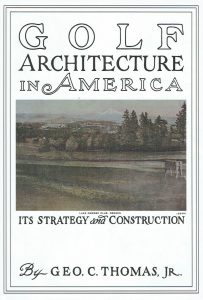 |
- Scotland’s Gift – Golf by Charles Blair Macdonald (New York, Charles Scribner’s Sons, 1928). My copy of this book is well worn, has foxed pages and a musty smell… but is cherished. Complete with the pull-out plan of The National Links of America tucked inside the back cover, this book by the man considered the Father of American Golf Course Architecture is a must read by any budding golf designer. Macdonald was a visionary and here he tells his story of his visits to St Andrews, his design principles, and his thoughts on construction.
- The Architectural Side of Golf by H.N.Wethered and T. Simpson (London, Longman’s Green & Co, 1929). Simpson came from a wealthy family and like his contemporary Harry Colt, practiced Law. His entry in golf design came after observing the redesign of Woking GC and the theories of fellow club member John Low. He was not afraid of following his own path and after working with Herbert Fowler, then Philip MacKenzie Ross, in the 1930s Simpson became the first designer to consult with a woman when he teamed up with notable golfer Molly Gourlay. Known for wearing a beret and touring the countryside in a silver Rolls-Royce, Simpson wrote a number of excellent essays prior to publishing this book with Wethered – which is noted for its wonderful green drawings and colour plans. As an artist who also practiced silk embroidery, this book is as educating, eccentric and colourful man as the man himself, and a British golf design classic.
- The Golf Course: Planning Design, Construction & Maintenance by F.W.Hawtree (London, E.&F.N. Spon, 1983) Classic golf course design philosophies and strategies had been beautifully described and illustrated in the best books published by the end of the 1930s. 50 years later the industry had changed with advances in turfgrass, drainage, irrigation and machinery. Hawtree, had been raised around golf and all things design related and this small book discussed the needs of the modern game, outlined the phases of design, and delved into technical elements such as cut and fill plans, billing, and schedules. For many golfers it provided valuable insights and information about costs and process of golf course design and renovations. It was reprinted many times and must be regarded as a key book of its time.
- Anatomy of a Golf Course by Tom Doak (New York, Lyons and Burford, 1992). Doak was part-time architecture editor of Golf Magazine, and part of a new generation of designers in the early 1990s. He had come up under Pete Dye and cut his teeth both in the office and on-site. I bought this book when I was studying Landscape Architecture at University of California – Davis. It was an absolute joy to read. No heavy lifting required, just a bright and breezy perspective on the golf course master planning. It explained design strategy in simple terms and provided ideas for anybody interested in golf course design – the book remains an excellent read. Interestingly, Gil Hanse, who also worked with Doak under Dye, collaborated on this book and contributed the diagrams. If you were looking for something more recent, Tom Doak’s Little Red Book of Golf Course Architecture(Traverse City, MI, Renaissance Golf Design, 2017) is a collection of his posts on Golf Club Atlas, and covers a pot pourri of his thoughts on golf course design – a great wee read.
- The Architects of Golf by G.S. Cornish & R.E. Whitten (New York, Rutledge Press, 1993). Geoffrey Cornish (b.1914-d.2012) was a prolific architect with over 200 courses to his name while Ron Whitten is an American lawyer. The book they produced is by far the best reference of golf architects and courses. When I am doing research, there may be days when this book never leaves my desk. Described as a ‘bible’, it is an encyclopaedia of designers and their work. Though a little out-of-date now, it is still very useful for courses built before 1993, and for biographical information on past architects. Ron Whitten once told me that they have continued updated their files on the architects and their work and hope to publish an updated book in the future – though it might be in two volumes! Let’s hope that happens.
- Golf Greens: History, Theory, Design & Construction (John Wiley & Sons, 2004) by Michael Hurdzan Ph.D. Hurdzan may be one of the foremost thinkers in the field of golf course design. Highly intelligent and well read, he has contributed a number of informative and interesting books on various aspects of golf course design and construction. Many people may know Golf Course Architecture: Design, Construction and Restoration (1996, r2005), but for me, his bookon greens is his pièce de résistance. An excellence reference book for designers, greenkeepers and golfers, it is a blend of history and vision that elevates our knowledge of this most important golf course feature. This a book greenkeepers and Green Committes should read.
- Bunkers, Pits and Other Hazards: A Study of Golf’s Defining Character. By F.L. Richardson & M.K.Fine. (Hoboken, NJ: John Wiley & Sons, Inc., 2005) If you prescribe to the idea that golf’s interest is derived from the hazards you must overcome between the tee and the hole, then this book is for you. Californian golf architect Forrest Richardson and co-designer Mark Fine have taken a wonderful and fun look into famous hazards, the design and construction and of hazards, and my favourite section – the psychological effects of hazards. The book comes with numerous illustrations and photos and could very well become a classic!
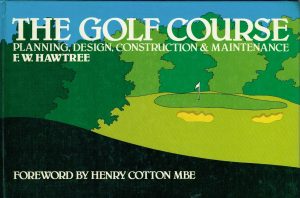 |
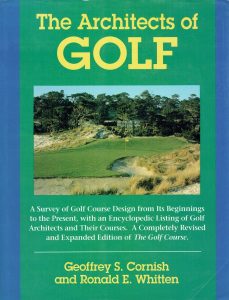 |
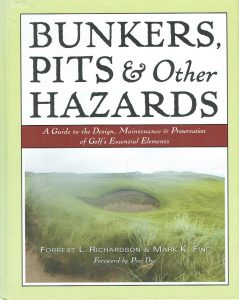 |
Those are 10 great books on golf course design written by golf architects. All these books have shaped or influenced my design thoughts in some way and I’m sure I’m not alone in being grateful these talented men put pen to paper (or fingers to keyboard). In the future more i’m sure great books will push there way into my list, but none of these books shall ever be less valuable or less influential literary works. If you come across any of these books, may I recommend that you take time to read a few pages – you will be richly rewarded. Happy reading!
References:
- Golf Course Design: An Annotated bibliography with highlights of its history and resources, by G.S. Cornish & M.J.Hurdzan. Grant Books, 2006.
- The Game of Golf and the Printed Word 1566-1985: A Bibliography of Golf Literature in the English Language. R.E Donovan, J.S.F. Murdoch. Castalio Press, New York, 1987
- The book of Golfers: A Biographical History of the Royal & Ancient Game. By Daniel Wexler. Sports Media Group. Ann Arbor, MI. 2005.
(1) The Architects of Golfby Cornish & Whitten (The Rutledge Press. 1993., p298)
(2) Simpson & Co – Golf Architects. By F.Hawtree. (Rhod McEwan Publishing, Ballater, 2016., p110-111)
AWARDS
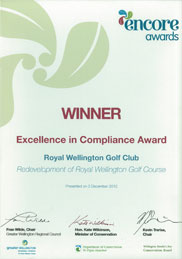 Winner
Winner
Excellence in Compliance Award
Royal Wellington Golf Club
 Scott awarded by GEO as a Sustainable Golf Champion
Scott awarded by GEO as a Sustainable Golf Champion
PUBLICATIONS
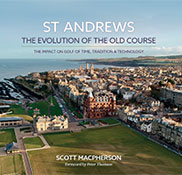 St Andrews
St Andrews
The Evolution of the Old Course
by Scott Macpherson
TESTIMONIALS
"During both the design and construction phases their can-do attitude to problem solving was refreshing".
Ben O'Malley, Millbrook Country Club, NZ



